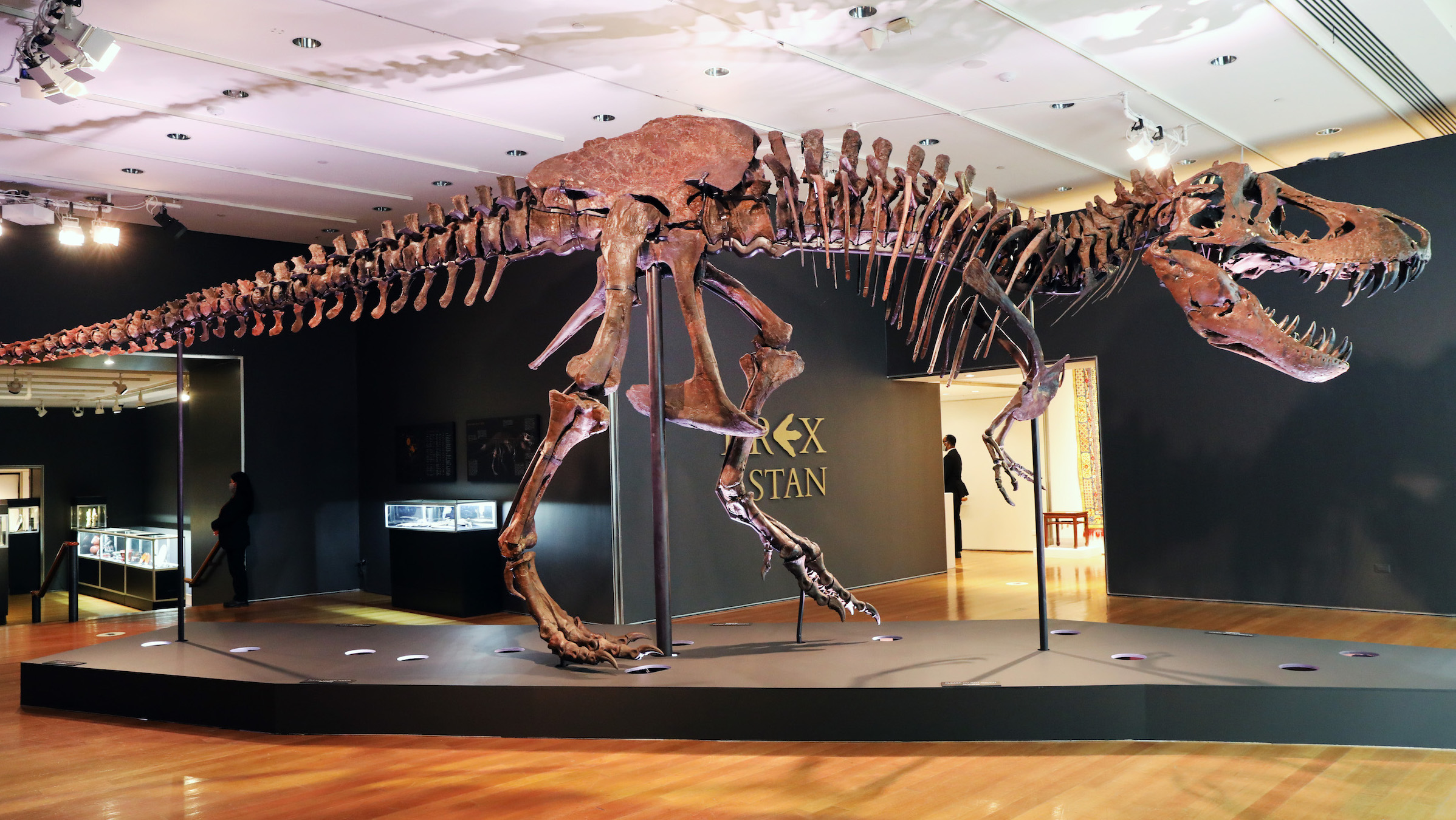Stan the T. rex just became the most expensive fossil ever sold
Stan sold for more than five times its low estimate.

A 67 million-year-old Tyrannosaurus rex specimen nicknamed Stan has just shattered a record; on Tuesday (Oct. 6), Stan was sold at Christie's New York for nearly $32 million. That makes it the most expensive fossil ever sold at an auction.
Previously, the priciest fossil to hit the auction block was an incredibly complete T. rex known as Sue, which sold for $8.36 million in 1997 ($13.5 million in today's dollars, given inflation) to the Field Museum of Natural History in Chicago. Meanwhile, the buyer of Stan has not been identified, according to The New York Times.
Many paleontologists are dismayed that Stan sold for so much to an unknown buyer, especially now that many scientific institutions don't have the money to purchase such fossils and keep them in the public domain. However, unlike other dinosaur specimens, Stan had no choice but to go to the auction block, so how did it end up there?
Related: In photos: Bizarre 'bat dinosaur' discovered in China
Normally, the Society of Vertebrate Paleontology (SVP) opposes the auction of such fossils. In 2018, for instance, SVP asked the Aguttes auction house in Paris to pull the plug on auctioning off an Allosaurus, a type of meat-eating dinosaur, that had been found on private land in Wyoming. In contrast, Stan came to the auction house not because its owner wanted to turn a profit, but through a court order, which complicated SVP's response.
Amateur paleontologist Stan Sacrison found Stan in 1987 in the Hell Creek Formation, near the town of Buffalo, South Dakota, according to the Black Hill Institute of Geological Research (BHI), a company that supplies fossils for research, teaching and exhibit. After learning about the specimen, BHI scientists spent more than 300,000 hours excavating and preparing the nearly 40-foot-long (12 meters) T. rex, which they named after its discoverer.
The T. rex became famous, headlining at the T. rex World Exposition, a yearlong tour that opened in Japan in 1995. In 2005, the BBC TV show "The Truth About Killer Dinosaurs" created a replica of Stan's skull and jaws to learn about T. rex bite force; and researchers reported in 2009 in the journal PLOS One how they had studied Stan to better understand how dinosaurs moved.
Sign up for the Live Science daily newsletter now
Get the world’s most fascinating discoveries delivered straight to your inbox.
Anatomical research on Stan revealed the T. rex had likely been through some vicious brawls; it had a broken neck, several other broken bones, healed ribs and a scar on its skull the same size and shape as a T. rex tooth, according to BHI.
However, BHI recently ended its relationship with one of its minority shareholders, according to a BHI statement. In 2015, this shareholder filed a lawsuit to liquidate the institute's assets, and in 2018 a judge ordered that BHI auction Stan off and then pay the proceeds to this shareholder for his interest in the company.
In light of the ruling, SVP acknowledged that BHI had no choice but to send Stan to the auction block. "In the case of Stan the T. rex the situation is more complex and we understand that the sale is the result of a court ruling," SVP said in a statement. "In this instance, we have requested that Christie's restrict the sale to bidders from institutions committed to curating specimens for the public good and in perpetuity, or those bidding on behalf of such institutions."
It's unclear whether the auction house heeded SVP's request. "But if the winning bid for Stan the T. rex came not from a museum but a private collector, then science is the loser — and high-profile auctions like these make that the most likely outcome, driving up the cost and pricing out museums," Adam Larson, a volunteer docent at the Dinosaur Discovery Museum in Kenosha, Wisconsin, wrote in an opinion piece for NBC News.
Museums are crucial for fossil preservation, as they employ scientists who know how to properly care for these specimens, as well as make them available to the public and researchers for years to come. "But private collectors operate under no such restrictions," Larson wrote. "They could sell parts of Stan to other collectors and split up the skeleton, or store it in a way that could lead to Stan being damaged, or grind up Stan for 'medicinal' soup, or even let their dogs chew on Stan if they so desired."
Larson called for legislation that would protect rare specimens like Stan. Right now, fossils found on private lands in the U.S. (with the landowner's permission) are "finder's keepers," while fossils found on public lands can typically be collected only by trained researchers with a Bureau of Land Management permit.
Editor's Note: This story was updated on Oct. 8 to fix the title of Adam Larson, who is a volunteer docent at the Dinosaur Discovery Museum.
Originally published on Live Science.

Laura is the archaeology and Life's Little Mysteries editor at Live Science. She also reports on general science, including paleontology. Her work has appeared in The New York Times, Scholastic, Popular Science and Spectrum, a site on autism research. She has won multiple awards from the Society of Professional Journalists and the Washington Newspaper Publishers Association for her reporting at a weekly newspaper near Seattle. Laura holds a bachelor's degree in English literature and psychology from Washington University in St. Louis and a master's degree in science writing from NYU.









